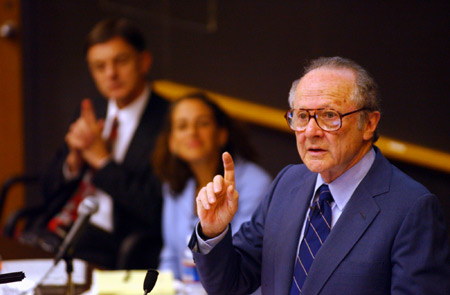SPH bioterrorism discussion timely

It is the nation’s public health system, not the military, that is squarely in the path of terrorist attacks using biological weapons, and it is the public health system that should be strengthened to deal with future assaults, according to experts gathered at the School of Public Health last week (Oct. 25-26).
The discussion drew approximately 300 people to the Special Dean’s Symposium titled “Bioterrorism: Public Health Peril/Public Health Response.” The three-hour symposium took place over two days and featured experts in biological weapons and in the public health response to the wave of anthrax infections.
School of Public Health Dean Barry Bloom said that the symposium was planned shortly after the Sept. 11 terrorist attacks but before the recent spate of anthrax mailings raised the profile of biological weapons.
“This is a very exciting thing for us, and timely in a way that wasn’t anticipated,” Bloom said.
The symposium’s first day featured David Franz, former commander of the U.S. Army Medical Research Institute of Infectious Diseases; Margaret Hamburg, vice president for biological programs of the Nuclear Threat Initiative; and Matthew Meselson, Thomas Dudley Cabot Professor of the Natural Sciences at Harvard and co-director of the Harvard Sussex Program on CBW Armament and Arms Limitation.
On the second day, Jonathan Burstein, a research scientist on emergency and disaster public health sciences at the Centers for Disease Control and Prevention and a doctor at Beth Israel Deaconess Medical Center’s Emergency Medicine Department, and Massachusetts Commissioner of Public Health Howard Koh addressed the symposium.
Together, the speakers painted a picture of the current danger from bioweapons as being very different from the situation that was often anticipated in the past. During the Cold War, the United States envisioned bioweapons being used on soldiers in a battlefield situation. Consequently, the military has been trained in what to do in the event of a biological or chemical weapons attack. The public has not.
It may be difficult to prevent the manufacture of biological weapons because much of the equipment used to culture biological agents, such as large fermenters, are legitimately used in other applications, like growing disease organisms to create vaccines – or culturing yeast to brew beer.
There is also a lot of expertise on biological warfare on the market, Franz said. Much of it stems from the collapse of the Soviet Union, which put 30,000 to 40,000 scientists who worked at the USSR’s former biological weapons labs out of work.
“The important issue is there were 30,000 to 40,000 scientists and engineers working at Soviet weapons facilities and they were suddenly out of work. They had families to support, children to feed,” Franz said. “The concern in this country is where did they go?”
Franz presented a list of possible biological agents that include bubonic plague, smallpox, anthrax, foot-and-mouth disease, African swine fever, and others. He said biological weapons vary greatly in their virulence and effectiveness. The contagious diseases such as smallpox that would make the best weapons are also the most difficult to handle and could even infect terrorists working with them.
The easiest diseases to work with, from a terrorist’s viewpoint, are agents such as anthrax, which though potentially deadly, are not contagious and whose ability to infect someone varies greatly. The danger from an external release, through a bomb or a crop duster, for example, would depend on the atmospheric conditions.
Another problem is that it can be very difficult to detect an actual outbreak. Many of the most likely agents first appear with flulike symptoms, which most medical personnel will treat as a more mundane condition. Several of the speakers called on greater training of medical personnel so they can recognize potential infections of more exotic illnesses – such as anthrax .
“We were taught [in medical school] that if you hear hoofbeats, don’t think zebra, think horse,” Hamburg said. “But now we have to at least rule out zebra. [Doctors] need to at least … learn to recognize something unusual and know who to call if they do.”
The government is going to spend a lot of money to fight the current anthrax scare and prepare for the next one. That money should be spent as much as possible, the speakers agreed, to strengthen the public health system – through training, vaccine research, building vaccine stockpiles – so it’s well-prepared for another such emergency.
“Public health is public safety and we now realize it’s an important pillar of our national security framework. We need to address it as if it were that important,” Hamburg said.
Massachusetts Public Health Commissioner Koh said communications with the public have to be improved, particularly with respect to accurately relaying risk. Even though several people have died of inhalational anthrax nationwide and even though the Massachusetts public health system is mobilized and on the lookout for anthrax cases, there has been no trace of the agent so far in this state.
“In Massachusetts, there have been no deaths, no cases, no infections, no documented exposure, yet the level of public anxiety is truly extraordinary,” Koh said.
In Boston, the public health system is already set up to at least identify a disease outbreak that results from either bioterrorism or naturally occurring epidemics, according to Burstein. Beginning last summer, each day hospitals automatically send counts of the number of people seen in their emergency rooms to a central computer at the Boston Public Health Commission, which compares the daily total with historical data and sends out alerts if the day’s numbers are higher.
The system so far has picked up an increased number of illnesses from a heat wave and a couple of outbreaks of gastrointestinal illnesses, Burstein said. That illustrates that strengthening the public health system can improve defense both against biological terrorism and naturally occurring conditions.
“We can meet the challenge. We’ve done it before for unintended epidemics, and we can do it again,” Burstein said.




